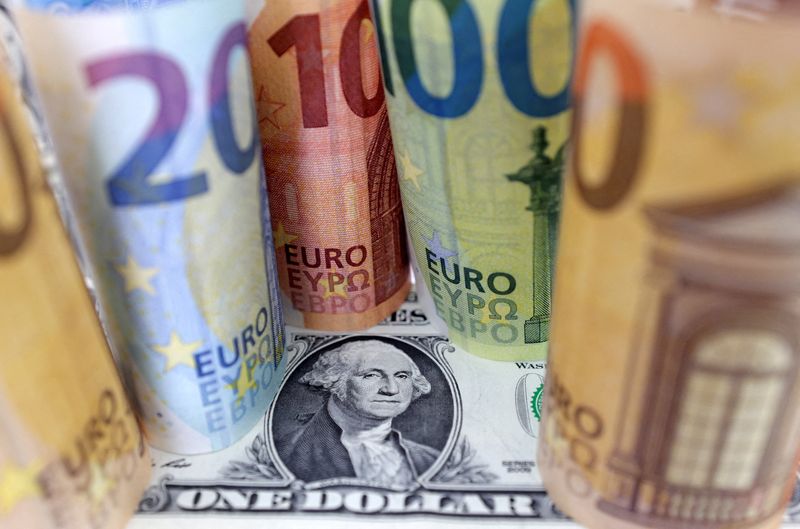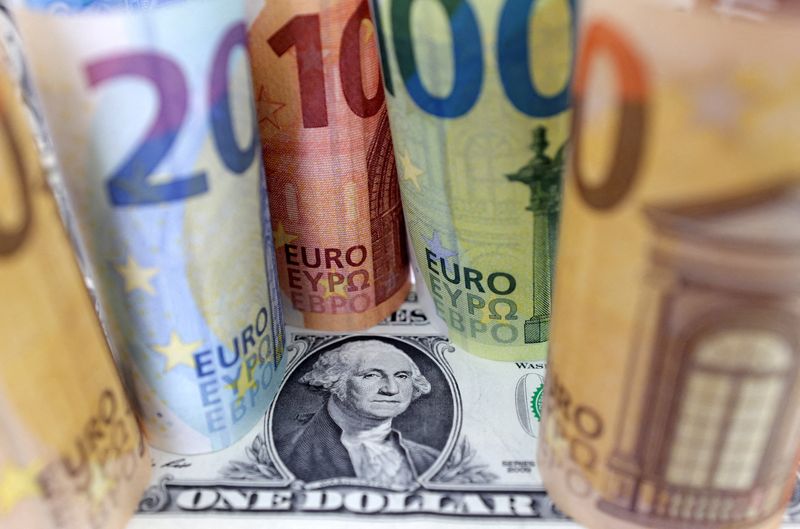Forex
Dollar drops to two-month low, yen hits 6-1/2 week high


© Reuters. FILE PHOTO: U.S. Dollar and Euro banknotes are seen in this illustration taken July 17, 2022. REUTERS/Dado Ruvic/Illustration/File Photo
By Samuel Indyk and Rae Wee
LONDON (Reuters) -The dollar slid to a more than two-month low on Monday, extending a downtrend from last week as traders reaffirmed their belief that U.S. rates have peaked and turned their attention to when the Federal Reserve could begin to cut.
The hit a low of 103.46 in European trade, its weakest level since Sept. 1, extending a nearly 2% decline from last week – the sharpest weekly fall since July.
Against the weaker greenback, the euro hit its highest since August at $1.0937, while the yen firmed to a 6-1/2 week high of 148.1 per dollar.
Markets have priced out the risk of further rate increases from the Fed after a slew of weaker-than-expected U.S. economic indicators last week, particularly after an inflation reading that came in below estimates.
Focus now turns to how soon the first rate cuts could come, with futures pricing in almost a 30% chance that the Fed could begin lowering rates as early as March, according to the CME FedWatch tool.
“The weakness in the dollar is to do with the moves in rate markets, especially after the November Fed meeting and last week’s CPI,” said Dane Cekov, senior FX strategist at Nordea, although he added that there could be weakness in the dollar in the very short term.
“From a technical perspective, the dollar now looks oversold against the euro. Usually you’ll see some sort of consolidation.”
Minutes from the Fed’s latest meeting, released on Tuesday this week, could offer some colour on policymakers’ thinking as they held rates steady for a second time this month.
Sterling was little changed at $1.2467, after earlier flirting with a near two-month peak.
The euro last bought $1.0926 ahead of flash PMI readings in the euro zone due this week and after Moody’s (NYSE:) unexpectedly upgraded the outlook on Italy’s ‘Baa3’ sovereign rating to stable from negative and upgraded Portugal’s rating by two notches to ‘A3’.
Nordea’s Cekov said the moves by Moody’s should be a positive for the euro area as they should lead to a lower risk premium for Italian and Portuguese debt.
“In that sense it removes some of the downside risk for the euro. That’s my first impression,” Cekov said.
The Japanese yen remained on the stronger side of 150 per dollar and was last around 0.8% higher at 148.42.
Elsewhere in Asia, the yuan leapt to a more than three-month high against the dollar in both the onshore and offshore markets, as the central bank guided the unit higher and exporters rushed to convert their dollar receipts into local currency.
The and both rose to 7.1633 per dollar, their highest level since Aug. 4.
The was last 0.5% higher at $0.6547, having struck a three-month high of $0.6563 earlier in the session, while the gained 0.5% to $0.6022.
China on Monday left its benchmark lending rates unchanged at a monthly fixing, matching expectations, as a weaker yuan continued to limit further monetary easing and policymakers waited to see the effects of previous stimulus on credit demand.
The yuan, which has fallen nearly 4% against the dollar this year in the onshore market, continues to be pressured by a faltering economic recovery in China and as investor sentiment remains fragile.
“I think the theme of a soft Chinese economic recovery will persist for a while,” said Carol Kong, a currency strategist at Commonwealth Bank of Australia (OTC:).
“Until we get a more meaningful recovery in the Chinese economy, I think that will be a headwind for the (yuan), Aussie and the kiwi in the near term.”

 Forex3 years ago
Forex3 years agoForex Today: the dollar is gaining strength amid gloomy sentiment at the start of the Fed’s week

 Forex3 years ago
Forex3 years agoUnbiased review of Pocket Option broker

 Forex3 years ago
Forex3 years agoDollar to pound sterling exchange rate today: Pound plummeted to its lowest since 1985

 Forex3 years ago
Forex3 years agoHow is the Australian dollar doing today?

 Cryptocurrency3 years ago
Cryptocurrency3 years agoWhat happened in the crypto market – current events today

 World3 years ago
World3 years agoWhy are modern video games an art form?

 Commodities3 years ago
Commodities3 years agoCopper continues to fall in price on expectations of lower demand in China

 Economy3 years ago
Economy3 years agoCrude oil tankers double in price due to EU anti-Russian sanctions






























